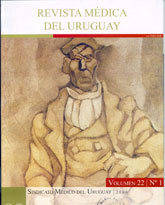El estado civil materno y su asociación con los resultados perinatales en una población hospitalaria
Resumen
Introducción: el objetivo de este estudio es analizar si existe asociación entre el estado civil materno y los resultados perinatales en la población de mujeres embarazadas que se asisten en el Centro Hospitalario Pereira Rossell.
Material y método: se analizó la asociación entre el estado civil y los resultados perinatales en 41.011 nacimientos de feto único en la maternidad pública de mayor cobertura en Uruguay –Centro Hospitalario Pereira Rossell– durante cinco años. Los resultados fueron ajustados para diferentes factores de riesgo mediante modelos de regresión lineal y logística.
Resultados: el estado civil "soltera" se asoció con un incremento del bajo peso al nacer (Odds Ratio ajustado [aOR] = 1,11; 95% CI: 1.02-1.20) y muerte fetal ([aOR] = 1,51; 95% CI: 1.24- 1.83). Otros factores que mostraron asociación con bajo peso al nacer y muerte fetal fueron: mal control prenatal, antecedentes de bajo peso al nacer (BPN) y muerte fetal. El hábito de fumar se asoció con un incremento del BPN (aOR = 1,30; 95% CI: 1.23-1.39).
Conclusiones: los resultados en nuestra población son concordantes con los publicados internacionalmente acerca de la asociación del estado civil y otros factores de riesgo con los resultados perinatales.
Citas
2) Ahmed F. Unmarried mothers as a high-risk group for adverse pregnancy outcomes. J Community Health 1990; 15(1): 35-44.
3) de-Sanjose S, Roman E. Low birthweight, preterm, and small for gestational age babies in Scotland, 1981-1984. J Epidemiol Community Health 1991; 45(3): 207-10.
4) Algert C, Roberts C, Adelson P, Frommer M. Low birth-weight in NSW, 1987: a population-based study. Aust N Z J Obstet Gynaecol 1993; 33(3): 243-8.
5) McIntosh LJ, Roumayah NE, Bottoms SF. Perinatal outcome of broken marriage in the inner city. Obstet Gynecol 1995; 85(2): 233-6.
6) Holt VL, Danoff NL, Mueller BA, Swanson MW. The association of change in maternal marital status between births and adverse pregnancy outcomes in the second birth. Paediatr Perinat Epidemiol 1997; 11 Suppl 1: 31-40.
7) Luo ZC, Wilkins R, Kramer MS. Disparities in pregnancy outcomes according to marital and cohabitation status. Obstet Gynecol 2004; 103(6): 1300-7.
8) Jonas O, Roder D, Chan A. The association of maternal and socioeconomic characteristics in metropolitan Adelaide with medical, obstetric and labour complications and pregnancy outcomes. Aust N Z J Obstet Gynaecol 1992; 32(1): 1-5.
9) Kurup A, Viegas O, Singh K, Ratnam SS. Pregnancy outcome in unmarried teenage nulligravidae in Singapore. Int J Gynaecol Obstet 1989; 30(4): 305-11.
10) Bor W, McGee TR, Fagan AA. Early risk factors for adolescent antisocial behaviour: an Australian longitudinal study. Aust N Z J Psychiatry 2004; 38(5): 365-72.
11) Perez R, Patience T, Pulous E, Brown G, McEwen A, Asato A, et al. Use of a focussed teen prenatal clinic at a military teaching hospital: model for improved outcomes of unmarried mothers. Aust N Z J Obstet Gynaecol 1998; 38(3): 280-3.
12) Díaz-Rossello JL. Health services research, outcomes, and perinatal information systems. Curr Opin Pediatr 1998; 10(2): 117-22.
13) Simini F. Perinatal information system (SIP): a clinical database in Latin America and the Caribbean. Lancet 1999; 354(9172): 75.
14) Cheung YB. Marital status and mortality in British women: a longitudinal study. Int J Epidemiol 2000; 29(1): 93-9.
15) Waldron I, Hughes ME, Brooks TL. Marriage protection and marriage selection–prospective evidence for reciprocal effects of marital status and health. Soc Sci Med 1996; 43(1): 113-23.
16) Ryan GM, Jr, Sweeney PJ, Solola AS. Prenatal care and pregnancy outcome. Am J Obstet Gynecol 1980; 137(8): 876-81.
17) Belizan JM, Villar J, Belizan MZ, Garrote N. [Care of pregnant women in prenatal services in public maternity hospitals of Rosario, Argentina]. Bol Oficina Sanit Panam 1979; 86(2): 121-30.
18) Raymond EG, Cnattingius S, Kiely JL. Effects of maternal age, parity, and smoking on the risk of stillbirth. Br J Obstet Gynaecol 1994; 101(4): 301-6.
19) Ahlenius I, Thomassen P. The changing panorama of late fetal death in Sweden between 1984 and 1991. Acta Obstet Gynecol Scand 1999; 78(5): 408-14.
20) Copper RL, Goldenberg RL, DuBard MB, Davis RO. Risk factors for fetal death in white, black, and Hispanic women. Collaborative Group on Preterm Birth Prevention. Obstet Gynecol 1994; 84(4): 490-5.
21) Harter L, Starzyk P, Frost F. A comparative study of hospital fetal death records and Washington State fetal death certificates. Am J Public Health 1986; 76(11): 1333-4.
22) Greb AE, Pauli RM, Kirby RS. Accuracy of fetal death reports: comparison with data from an independent stillbirth assessment program. Am J Public Health 1987; 77(9): 1202-6.














